A Data Logger is an essential device used for collecting, storing, and analyzing data over a specified period. It plays a critical role in various industries, enabling real-time monitoring and recording of key parameters such as temperature, humidity, pressure, pH, and more. By automating data collection and minimizing manual intervention, data loggers help ensure accuracy, reliability, and efficiency in the management of environmental and industrial processes.
What is A Data Logger?
A Data Logger is an electronic device used to automatically record data on various parameters at certain time intervals. It is often used to monitor and record environmental conditions or equipment operating status. Commonly monitored parameters include temperature, humidity, pressure, current, voltage, flow rate, TDS (Total Dissolved Solids), pH, and more.
How Data Loggers Work
Data Logger use sensors to detect environmental or equipment status in real time and store the data in internal memory. This data can be exported, analysed and processed through software. Some advanced Data Loggers are also equipped with wireless transmission capabilities, enabling real-time data transfer to a cloud or monitoring system for remote monitoring and data management.
Application
- Environmental Monitoring
- Industry and Manufacturing
- Agriculture
- Cold Chain Logistics
Data Logger Input Type
1. Analogue Inputs
- Description: Accepts continuous analogue signals such as voltage and current, usually used to measure physical parameters (e.g. temperature, humidity, pressure, etc.).
- Application: Commonly used for signals output from temperature sensors, pressure sensors, humidity sensors and other devices.
- Examples: 4-20 mA (current signal), 0-5 V, 0-10 V (voltage signal).

2. Digital Inputs
- Description: Receives digital signals, usually switching states (on/off) or pulse signals.
- Application: Used for monitoring state changes (e.g. device switching, alarm triggering) or counting (e.g. flow meters, counters, etc.).
- Examples: Binary input, pulse input, ON/OFF status signal.
3. Thermocouple Inputs
- Description: Designed for connecting thermocouple sensors to measure temperatures in high or low temperature environments.
- Application: Suitable for temperature measurement in high temperature environments, commonly used in industrial furnaces, refrigeration systems, engines and so on.
- Examples: Thermocouple types such as K type, J type, T type, E type and so on.

4. Resistance Temperature Dissipation (RTD) Inputs
- Description: For receiving signals from RTD (Resistance Temperature Detector) sensors, suitable for precise temperature measurement.
- Application: Suitable for temperature monitoring applications that require high accuracy, such as laboratories, food processing, pharmaceuticals, and other fields.
- Example: RTD types such as PT100, PT1000, etc.
5. Pulse Input
- Description: Receives pulse signals for recording events or accumulated values.
- Application: Suitable for metering flow rate (e.g. water, gas flow meter) or event counting (e.g. number of door openings and closures).
- Example: flow meter pulse signal input, suitable for recording total or count.
6. Serial Communication Inputs
- Description: Receive data stream transmitted by digital devices, usually used for data acquisition and device communication.
- Application: Used to connect other intelligent devices (e.g. PLC, sensor network) for data acquisition or control.
- Example: RS232, RS485, Modbus and other communication protocols.
7. Wireless Input
- Description: Receive data through wireless transmission technology, such as Bluetooth, Wi-Fi, LoRa, etc.
- Application: Suitable for remote monitoring, commonly used in application scenarios where wiring is not possible.
- Example: wireless sensor node in environmental monitoring system.
Advantages of Data Logger
Automated recording: No need for manual operation, able to record data continuously and reduce manual errors.
High precision and large capacity: It can run stably for a long time, suitable for large-scale data collection.
Convenient data analysis: Recorded data can be stored and exported for later analysis and optimisation.
Summary
Data Logger is an invaluable tool for organizations looking to optimize their monitoring systems and make data-driven decisions. Whether it’s for environmental monitoring, quality control, or process optimization, data loggers provide reliable, continuous, and precise data collection.
Apure is dedicated to providing high-quality water quality monitoring solutions for various industries. Our product range is extensive, featuring advanced intelligence and flexibility, with reliable performance to meet the needs of diverse users. We welcome you to contact us to customize a professional water quality monitoring solution.
